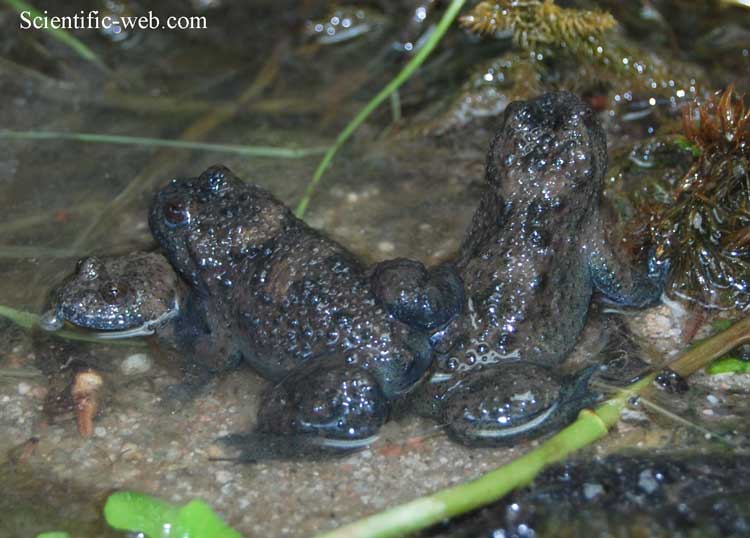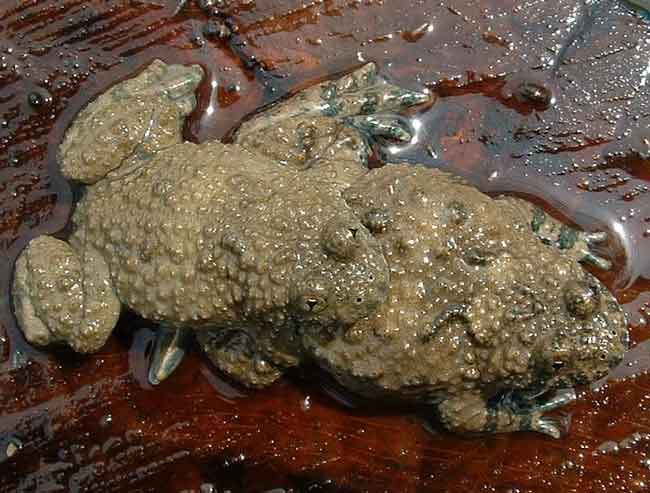
Bombina variegata , Photo: Michael Lahanas
Superregnum: Eukaryota
Regnum: Animalia
Subregnum: Eumetazoa
Cladus: Bilateria
Cladus: Nephrozoa
Superphylum: Deuterostomia
Phylum: Chordata
Cladus: Craniata
Subphylum: Vertebrata
Infraphylum: Gnathostomata
Superclassis: Tetrapoda
Classis: Amphibia
Subclassis: Lissamphibia
Ordo: Anura
Familia: Bombinatoridae
Genus: Bombina
Species: Bombina variegata
Subspecies: B. v. gracilis – B. v. kolombatovici – B. v. scabra – B. v. variegata
Name
Bombina variegata (Linnaeus, 1758)
Type locality: "Exteris regionibus"
Holotype: Not designated
Original combination: Rana variegata
Synonyms
Bufo salsus Schrank in Schrank & Moll, 1785
Rana sonans Lacépède, 1788
Rana salsa — Gmelin, 1789
Bombinator brevipes Blasius, 1839
Bombinator scaber Küster, 1843
Bombina maculatus Gistel, 1868
Bombina igneus var. brevipes — Koch, 1872
Bombinator pachypus var. Kolombatovici Bedriaga, 1890
Bombinator pachypus var. brevipes — Boulenger, 1896
Bombinator pachypus var. nigriventris Dürigen, 1897
Bombinator variegata — Poche, 1912
Bombina salsa — Nikolskii, 1918
Bombina salsa var. csikii Fejérváry, 1922
Bombina variegata — Mertens, 1928
Bombina variegata variegata — Mertens & Müller, 1928
Bombina variegata csikii — Mertens & Müller, 1928
Bombina variegata kolombatovici — Mertens & Müller, 1928
Bombina variegata gracilis Bolkay, 1929
Bombina variegata scabra — Müller, 1940
Bombina (Bombina) variegata — Tian & Hu, 1985
References
Linnaeus, C. 1758. Systema Naturae per regna tria naturæ, secundum classes, ordines, genera, species, cum characteribus, differentiis, synonymis, locis, Tomus I. Editio decima, reformata. Holmiæ: impensis direct. Laurentii Salvii. i–ii, 1–824 pp DOI: 10.5962/bhl.title.542: 211. Reference page.
Tian and Hu, 1985, Acta Herpetol. Sinica, N.S., '4: 219–224.
Frost, D.R. 2021. Amphibian Species of the World: an Online Reference. Version 6.1. Electronic Database accessible at https://amphibiansoftheworld.amnh.org/index.php. American Museum of Natural History, New York, USA. DOI: 10.5531/db.vz.0001 Bombina variegata . Accessed on 14 July 2008.
2007 IUCN Red List of Threatened Species IUCN: Bombina variegata (Least Concern) Downloaded on 14 July 2008.
Vernacular names
български: Жълтокоремна бумка
català: Gripau raucador de ventre groc
čeština: Kuňka žlutobřichá
Deutsch: Gelbbauchunke
English: Yellow-bellied toad
español: Sapillo de vientre amarillo
français: Sonneur à ventre jaune
hrvatski: Žuti mukač
magyar: Sárgahasú unka
italiano: Ululone dal ventre giallo
日本語: キバラスズガエル
Nederlands: Geelbuikvuurpad
polski: Kumak górski
português: Bombina variegata
русский: Желтобрюхая жерлянка
slovenčina: Kunka žltobruchá
српски / srpski: Жутотрби мукач
svenska: Gulbukig klockgroda
українська: Кумка жовточерева
Tiếng Việt: Cóc tía bụng vàng
中文: 多彩铃蟾

Bombina variegata (Source)
The yellow-bellied toad (Bombina variegata) belongs to the order Anura, the archaeobatrachial family Bombinatoridae, and the genus of fire-bellied toads.
Morphology and physiology
Specimens range from 28–56 mm, typically weighing between 2.3 and 12 g.[1] This places them among the smaller members of the family Bombinatoridae, which can reach sizes of 7 cm. Their top side is grey-brown, often with washed-out, bright spots. Their under side, including the inner sides of the limbs, fingers, and toes, is grey-blue to black-blue with striking, bright yellow to orange spots or patches, usually covering more than half of the underside. Yellow-bellied toads have compact bodies - though not so flat as the related European fire-bellied toad - and a rounded snout. The pupils are heart-shaped, with the eardrums not visible. The overside has numerous warts with raised swirls. A study conducted by researchers from Brill Academic Publishers had concluded that there are sexually dimorphic differences noted within the species. Males of the species have notably longer humerus length resulting in a longer forelimb length; It is believed to give them an advantage while coupling and while fighting other males of the same species. [2]
Variation
A study conducted by Bogdan Stugren and Stefan Vancea in 1968 on yellow-bellied toads in Romania and the USSR established eight different forms of B. variegata, expanding on the three forms previously posited by Michalowski in 1958.[3] Each of these forms represents a ratio of yellow to black markings on the underside of the toad, ranging from nearly completely yellow (Form 1) to nearly completely black (Form 8). Stugren and Vancea found that the undersides of B. variegata specimens from northern regions typically had greater coverage by black markings than those that were found in southern regions.
Life cycle
Eggs
B. variegata lays 73 eggs on average,[4] with clutch size ranging from 45 to more than 100 eggs. Individuals typically lay multiple clutches every summer, allowing a single female to produce as many as 300 eggs in a year. Eggs are 1.5-2mm large and coated in a jelly 5-8mm thick and semi-opaque, ranging in color from mud-like to light brown.[1] Tadpoles typically hatch within 4 days after eggs are laid.
Tadpoles
Tadpoles develop rapidly and can reach 55mm in length. They have a blunt tail and are typically grayish-brown or, in rare cases, transparent.[1] Tadpoles and eggs are vulnerable to predation from various small pond-dwelling creatures, such as leeches, fish, and some aquatic beetles.[5] A study published in 2016 in the Canadian Journal of Zoology indicated that tadpoles in warmer water develop more quickly than those in cooler climates, meant to mimic the differing environments found in forested areas and sunny quarries.[6]
Mating
Males begin to produce mating calls in the late spring and continue as late as August.[7] As the species does not have a vocal bladder, in contrast to the red-bellied toad, its call is quite gentle.
Distribution
A pair of yellow-bellied toads in amplexus
Note the heart-shaped pupils
Yellow-bellied toad (Bombina variegata)
Menu
0:00
Mating calls
The yellow-bellied toad is an amphibian closely bound to areas of water. Originally, the species typically lived along brooks and rivers. It settled there dependent on the flood dynamic of temporary and continuously shifting small bodies of water. In its replacement habitats in human civilization, it is still dependent on temporary small bodies of water on loamy ground, such as tractor trails, puddles, and small ditches. Mostly, these areas are bereft of vegetation and free of competing species and predators. Through the quick heating of small bodies of water, a rapid development of spawn and larvae is guaranteed. These pioneer species can be found mainly in quarries, clay and gravel pits, and on marching grounds.
The superior mobility of the young of the species allows spontaneous settlement of newly discovered living spaces. On land, the creatures look for hiding places under stones or dead wood and in the furrows and crevices of rocks. The yellow-bellied toad dwells in mountainous and hilly countries in middle and southern Europe. It is widely spread across the high hill area of middle and southern Germany and the Upper Rhine River Plains, but in few places.
Bombina variegata-yellow-bellied toad.jpg
Synonyms
Rana variegata, Linnaeus, 1758[8]
Bombynator pachypus, Bonaparte 1838[8]
References
"Yellow-bellied Toad". World Association of Zoos and Aquariums. WAZA. Retrieved 10 November 2017.
Rita, Anna; Cerbo, Di (2012). "Are there real sexual morphometric differences in yellow-bellied toads (Bombina spp.; Bombinatoridae)?". Amphibia-Reptilia. 33 (2): 171–183. doi:10.1163/156853812X634062.
Stugren, Bogdan; Vancea, Stefan (December 1968). "Geographic Variation of the Yellow Bellied Toad (Bombina Variegata) (L.) from the Carpathian Mountains of Romania and the USSR". Journal of Herpetology. 2 (3–4): 97–105. doi:10.2307/1563107. JSTOR 1563107.
Hogan, C. Michael. "Bombina variegata; Yellow-bellied Toad". Encyclopedia of Life. Discover Life. Retrieved 14 November 2017.
"Yellow-bellied Toad: Bombina variegata'" (PDF). The European Commission. EU Wildlife and Sustainable Farming Project 2009. Retrieved 22 November 2017.
Dittrich, Carolin; Drakulić, Sanja; Schellenberg, Madlen; Thein, Jürgen; Rödel, Mark-Oliver (February 2016). "Some like it hot? Developmental differences in Yellow-bellied Toad (Bombina variegata) tadpoles from geographically close but different habitats". Canadian Journal of Zoology. 94 (2): 69–77. doi:10.1139/cjz-2015-0168.
Kuzmin, Sergius L. (19 February 2009). Kellie Whittaker (ed.). "Bombina variegata". AmphibiaWeb. University of California, Berkeley. Retrieved 4 January 2020.
"Yellow-bellied toad - Bombina variegata (Linnaeus, 1758)". European Environment Agency. Retrieved 2019-05-21.
Sergius Kuzmin, Mathieu Denoël, Brandon Anthony, Franco Andreone, Benedikt Schmidt, Agnieszka Ogrodowczyk, Maria Ogielska, Milan Vogrin, Dan Cogalniceanu, Tibor Kovács, István Kiss, Miklós Puky, Judit Vörös, David Tarkhnishvili, Natalia Ananjeva (2009). "Bombina variegata". IUCN Red List of Threatened Species. 2009: e.T54451A11148290. doi:10.2305/IUCN.UK.2009.RLTS.T54451A11148290.en. Retrieved 12 November 2021. Database entry includes a range map and justification for why this species is of least concern
Much of the content of this article comes from the equivalent German-language Wikipedia article (retrieved 14 February 2006)
Retrieved from "http://en.wikipedia.org/"
All text is available under the terms of the GNU Free Documentation License

